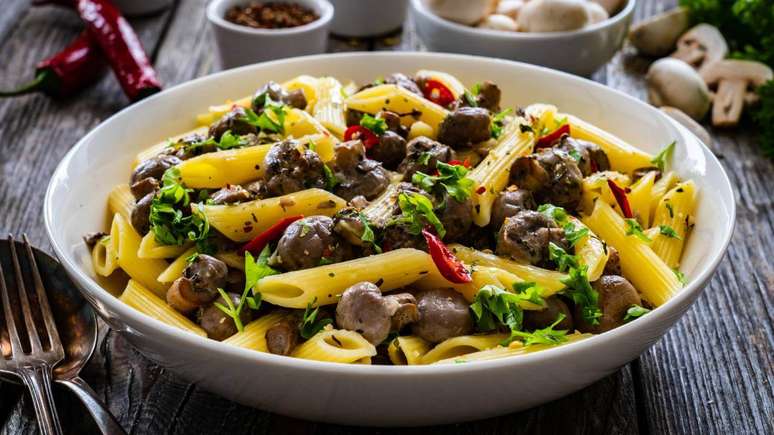The researchers developed a recipe from the flour made with the leaves
His huge leaves offer iron, soccerPotassium, magnesium, zinc, in addition to vitamins A and C. to complete, team fiber and are rich in antioxidant action compounds. This mixture, found in TaiobaIt helps to enrich the recipes, as demonstrated by a study conducted by researchers from the Federal Institute of Mato Grosso do Sul (IFMS) and the Federal University of Mato Grosso do Sul (UFMS).
The work was recently published in the scientific journal Brasiliano Journal of Food Technology And it brings details on the creation of Taioba Muffin. The process involved by the drying of the leaves to obtain a flour to the sensory evaluation by a group of volunteers.
“The gnocchi presented greater mineral salts than the recipes prepared only with wheat flour,” says Claudia Leite Munhoz Claudia Leite Munhoz, teacher of IFMS and one of the authors of the research. They were also approved by consumers.
Among the main nutrients found in vegetables, the salient points go to iron, an indispensable mineral in the fight against anemia; Potassium, ally of the muscles; As well as calcium and phosphorus, doubles that favors the bones. It also offers vitamin A, essential for eye health and vitamin C, which contribute to immunity.
Taioba is also a source of fiber, the guardians of intestine. And it is distinguished by the concentration of phenolic compounds, a group of antioxidant action substances that appears in studies as protector of the arteries.
In addition to the foliage, the species contains a type of “potato”, rich in starch. “In some regions, the rhizome is usually more appreciated than the leaves and end up going to the garbage,” says Claudia.
For the nutritionist Hilana Santos Veras Pereira Negrão, of the Einstein Israelita hospital, the use of sheets in recipes, such as the muffin studio, is a good strategy to avoid waste. “Although Taioba is popular in some cities of Minas Gerais, it is a food that deserves more space in the Brazilian menu,” he comments.
But the challenge is to find it in supermarkets and vegetables. This is because vegetables do not have a consolidated production chain. For now, the tip is to buy directly from small producers and in biological fairs.
Not all the Taioba are the same
Originally from South America, Taioba naturally appears in some parts of the Brazilian coast, as well as some cities within Minas Gerais and Goiás. The plant can reach two meters in height and its leaves reach 80 centimeters (cm) long and 60 cm wide. “There is also a type of Taioba, the Angry, who is not edible,” says Claudia. Concentrates a large amount of calcium bone, which can trigger swelling in the throat and feeling of asphyxiation.
The ancients knew how to differentiate themselves easily, therefore the importance of saving traditions and allowing knowledge to expand the food variety. Some clues, however, can help in the distinction.
“The scientific name of toxic species, the angry, is AntiquorumAnd she has the purple stem “, teaches Einstein’s nutritionist. (Xanthosoma Sagittifoliium) Also known as Taioba–True, it has a green rod. “His sheet, with a shape reminiscent of a heart, is all overcome by a thin line”, detail.
USA in the kitchen
Also for Manesa Taioba, the recommendation is to cook it before consumption, as it concentrates some anti -power compounds that may interrupt the use of mineral salts.
One of the most traditional ways of preparation has jumped, together with a lot of garlic. Its flavor is between cabbage and spinach.
The leaves go beyond mass filling, ravioli or pastels, cakes and quiche. It also enriches rice and soups. For those who want to increase bread, pancakes or gnocchi, the tip is dried in the oven and, after dehydration, beat the blender up to a flour.
The wealth of the PIG
In addition to Taioba, other unconventional food plants have been studied, Pancs and are becoming increasingly known. See some popular:
- Purslane
It is often considered a plague in many places, as it grows spontaneously on the land of all Brazilian regions. But its succulent leaves offer a type of omega-3 fat, anti-inflammatory fat. Okay in salads.
- Berthlate
Also called the calendar is a type of lives that contains vitamins A and C, among other micronutrients. Fresh leaves increase salads, but they seem large in stews and braised, for example.
- -Gomi
Another rustic species that grows easily in all regions of Brazil. Its leaves are rather versatile in the kitchen and younger, more tender and suitable for salads. Among the nutrients, mineral salts are distinguished as potassium, magnesium and calcium.
Today it is one of the most famous ABGES. Part of its success is due to the high concentration of nutrients. Its leaves provide mineral salts such as magnesium, zinc and copper, as well as a special type of fiber, mucilage, which contributes to intestinal health. It also offers proteins. The vegetable is combined with chicken and thickens cooked, among other preparations.
- Fiancée
The nickname of this species (Stachys Byzina) It comes from the similarity with the taste of fried fish, including the most common form of consumption, which acts as a snack. Contains fiber and vitamin C.
- Vinegar
Its scientific name is Hibiscus sabdariff And, in addition to being a vinegar, it’s called Caruru-Caru. Its leaves are used in the preparation of a typical Marahão dish, Cuxa rice, but also enriched, with vitamins and minerals, soups and salads, for example.
Source: Terra
Ben Stock is a lifestyle journalist and author at Gossipify. He writes about topics such as health, wellness, travel, food and home decor. He provides practical advice and inspiration to improve well-being, keeps readers up to date with latest lifestyle news and trends, known for his engaging writing style, in-depth analysis and unique perspectives.







